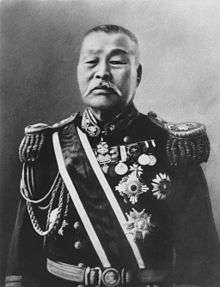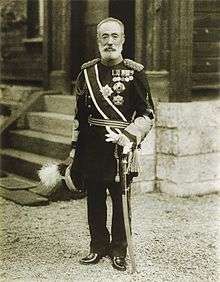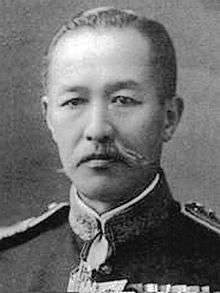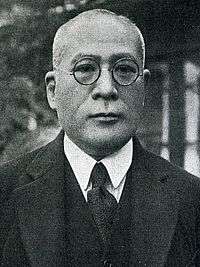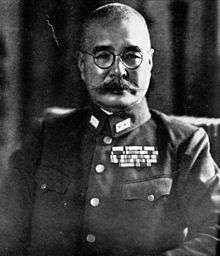List of rulers of Taiwan
Part of a series on the |
||||||||||||||||
|---|---|---|---|---|---|---|---|---|---|---|---|---|---|---|---|---|
| History of Taiwan | ||||||||||||||||
 | ||||||||||||||||
| Chronological | ||||||||||||||||
|
||||||||||||||||
| Topical | ||||||||||||||||
| Local | ||||||||||||||||
| Lists | ||||||||||||||||
|
| ||||||||||||||||
Dutch Formosa (1624–1662)
The Dutch Empire, during the period of the Dutch United Provinces and under the auspices of the Dutch East India Company (VOC), attempted to conquer Macau in 1622. Later they colonized the Pescadores Islands, where they built a fort in Makung. In 1624, the Chinese attacked, and the Dutch were driven to Taiwan (then called Formosa, meaning "beautiful island"). That year they established Fort Zeelandia on Taiwan's southwest coast. In 1637, the Dutch conqurered Favorolang (also Favorlang; present day Huwei, Yunlin). The names listed here are the Dutch governors:[1]
| № | Portrait | Name | Term |
|---|---|---|---|
| 1 | Martinus Sonck | 1624 - 1625[2] | |
| 2 | Gerard Frederikszoon de With | 1625 - 1627 | |
| 3 |  | Pieter Nuyts | 1627 - 1629 |
| 4 | Hans Putmans | 1629 - 1636 | |
| 5 | Johan van der Burg | 1636 - 1640[2] | |
| 6 | Paulus Traudenius | 1640 - 1643 | |
| 7 | Maximilian le Maire | 1643 - 1644 | |
| 8 | François Caron | 1644 - 1646 | |
| 9 |  | Pieter Anthoniszoon Overtwater | 1646 - 1649 |
| 10 | Nicolas Verburg | 1649 - 1653 | |
| 11 | Cornelis Caesar | 1653 - 1656 | |
| 12 |  | Frederick Coyett | 1656 - 1662 |
| Harmen Klenck van Odessen[3] | |||
Spanish Formosa (1626–1642)
In response to the Dutch settlements, the Spanish settled at Keelung on the northeast coast of the island in 1626 and built Fort San Salvador. Later they built another outpost, Fort San Domingo, at Tamsui in the northwest. In 1629 these forts had a combined total of about 200 Spaniards and 400 Filipinos. By 1635, the Tamsui settlement was abandoned; however, the Keelung settlement remained in Spanish hands until 1642, when a Dutch force of 11 ships and 1,000 men attacked the fort of 446 people. The Spanish surrendered.
Kingdom of Tungning (1662–1683)
The Southern Ming (Ming Dynasty loyalists) invaded Taiwan under Koxinga, expelling the Dutch and capturing Fort Zeelandia. They established the Kingdom of Tungning.
| № | Portrait | Name (Birth–Death) |
Title(s) | Reign (Lunar calendar) | |
|---|---|---|---|---|---|
| 1 |  |
Zheng Chenggong (Koxinga) 鄭成功 Zhèng Chénggōng (1624–1662) |
Prince of Yanping (延平王) Prince Wu of Chao (潮武王) |
14 June 1661 Yongli 15-5-18 | 23 June 1662 Yongli 16-5-8 |
| 2 | Zheng Xi 鄭襲 Zhèng Xí (1625–?) |
Protector (護理) | 23 June 1662 Yongli 16-5-8 | November 1662 Yongli 17 | |
| 3 | Zheng Jing 鄭經 Zhèng Jīng (1642–1681) |
Prince of Yanping (延平王) Prince Wen of Chao (潮文王) |
November 1662 Yongli 17 | 17 March 1681 Yongli 35-1-28 | |
| 4 | Zheng Kezang 鄭克𡒉 Zhèng Kèzāng (1662–1681) |
Prince Regent (監國) | 17 March 1681 Yongli 35-1-28 | March 1681 Yongli 35 | |
| 5 | Zheng Keshuang* 鄭克塽 Zhèng Kèshuǎng (1670–1707) |
Prince of Yanping (延平王) Duke Haicheng (海澄公) |
March 1681 Yongli 35 | 5 September 1683 Yongli 37-8-13 | |
* Regency of Feng Xifan from 1682 to 1683.
Taiwan under Great Qing (First period, 1683–1721)
- The Qing Dynasty invaded Taiwan; the Ming rulers surrendered and were expelled.
- Kangxi Emperor (1683–1721)
- Taiwan-Xiamen Circuit Commissioner (福建分巡台灣廈門道, 1687—1727)
| № | Commissioner | Start of office |
|---|---|---|
Taiwanese revolt (1721)
Taiwan under Great Qing (Second period, 1721–1895)
- Qing rule was reestablished after a month-long revolt. The Taiwan Circuit was established in 1727 with its seat in Taiwan-fu, unlike its predecessor, the Taiwan-Xiamen Circuit, which was based in Xiamen. The Taiwan Circuit Commissioner had its powers checked by the Taiwan Circuit Investigating censors.
|
|
- Taiwan Military Circuit Commissioner (福建分巡臺灣兵備道, 1767-1791)
| № | Commissioner | Start of office |
|---|---|---|
- Provincial Censor-ranked Taiwan Military Circuit Commissioner (按察使銜分巡台灣兵備道, 1791-1895)
| № | Commissioner | Start of office |
|---|---|---|
Governor of Fujian-Taiwan Province
| № | Portrait | Name (Birth–Death) |
Ancestry | Original Post | Term of Office (Lunar calendar) | |
|---|---|---|---|---|---|---|
| 1 |  |
Liu Mingchuan 劉銘傳 Liú Míngchuán (1836–1896) |
Hefei, Anhui | Governor of Fujian | 12 October 1885 Guangxu 11-9-5 | 4 June 1891 Guangxu 17-4-28 |
| — | Shen Yingkui[4] 沈應奎 Shěn Yìngkuí |
Pinghu, Zhejiang | Civil Affairs Minister, Fujian Province | 4 June 1891 Guangxu 17-4-28 | 25 November 1891 Guangxu 17-10-24 | |
| 2 | Shao You-lien 邵友濂 Shào Yǒulián (1840–1901) |
Yuyao, Zhejiang | Governor of Hunan | 9 May 1891 Guangxu 17-4-2 | 13 October 1894 Guangxu 20-9-15 | |
| 3 |  |
T'ang Ching-sung 唐景崧 Táng Jǐngsōng (1841–1903) |
Guanyang, Guangxi | Civil Affairs Minister, Fujian-Taiwan Province | 13 October 1894 Guangxu 20-9-15 | 20 May 1895 Guangxu 21-4-26 |
Republic of Formosa (1895)
Following its defeat in the First Sino-Japanese War (1894–1895), China ceded Taiwan and the Pescadores to the Empire of Japan in perpetuity, with a grace period for inhabitants wishing to remain Qing Dynasty subjects to sell their property and return to the Great Qing. The date set for the handover was June 2, 1895.
However, the Republic of Formosa was formed on May 25, 1895 by a group of Qing officials and local gentry with its capital at Tainan to resist impending Japanese rule. The republic lasted for less than six months; on October 21, 1895 Imperial Japanese Army forces entered the capital and quelled the resistance. The Republic of Taiwan had two presidents:
| № | Portrait | Name (Birth–Death) |
Place of Birth | Term of Office | Days | |
|---|---|---|---|---|---|---|
| 1 |  |
T'ang Ching-sung 唐景崧 Táng Jǐngsōng (1841–1903) President |
Guilin, Guangxi, |
23 May 1895 | 5 June 1895 | 13 |
| 2 |  |
Liu Yung-fu 劉永福 Liú Yǒngfú (1837–1917) Commander-in-chief |
Qinzhou, Guangdong, |
5 June 1895 | 21 October 1895 | 138 |
Taiwan under Japanese Empire (1895–1945)
After establishing control over the island, the Japanese used the French Empire model of an occupying force and were instrumental in the industrialization of the island; they built railroads, a sanitation system and a public school system, among other things. Around 1935, the Japanese began an island-wide assimilation project to bind the island more firmly to the empire.
In 1941, war broke out when the Japanese attacked the U.S. naval port of Pearl Harbor in Hawaii. By 1945, desperate plans were in place to incorporate popular representation of Taiwan into the Imperial Diet to end colonial rule of the island and transfer occupying troops to the front lines to fight the Allies. The names listed here are the Japanese governor-generals:
Military Rikken Seiyūkai Kenseikai Rikken Minseitō
Taiwan under Republic of China (1945-Present)
Following the end of World War II in 1945, under the terms of the Instrument of Surrender of Japan, Japan provisionally accepted the Potsdam Declaration (which referenced the never-signed Cairo Declaration), under which the island was to be transferred to the Republic of China. ROC troops were authorized to come to Taiwan to accept the surrender of Japanese military forces on behalf of Allied Powers in General Order No. 1, issued by Douglas MacArthur, the Supreme Commander of the Allied Powers, on September 2, 1945. ROC troops were later transported to Keelung by the U.S. Navy, and Japanese handed the control of Taiwan to the ROC on October 25, 1945. Following its defeat in the Chinese Civil War in 1949, Premier Yan Xishan proclaimed the ROC Government's relocation to Taiwan (where it exists until today), thus replacing the Provincial Chairperson as the highest-ranked executive official on Taiwan. This lasted until March 1950, when Chiang Kai-shek resumed his duties as President in Taipei.
Kuomintang Democratic Progressive Party
Chief Executive
| № | Portrait | Name (Birth–Death) |
Term of Office | Political Party | |
|---|---|---|---|---|---|
| 1 |  |
Chen Yi 陳儀 Chén Yí (1883-1950) |
August 29, 1945 | April 22, 1947 | Kuomintang |
Chairperson of the Provincial Government
| № | Portrait | Name (Birth–Death) |
Term of Office | Political Party | |
|---|---|---|---|---|---|
| 1 |  |
Wei Tao-ming 魏道明 Wèi Dàomíng (1899-1978) |
May 16, 1947 | January 5, 1949 | Kuomintang |
| 2 |  |
Chen Cheng 陳誠 Chén Chéng (1897–1965) |
January 5, 1949 | December 21, 1949 | Kuomintang |
Premier of the Republic of China (7 December 1949—1 March 1950)
| № | Portrait | Name (Birth–Death) |
Term of Office | Days | Political Party | President | |
|---|---|---|---|---|---|---|---|
| 26 |  |
Yan Xishan 閻錫山 Yán Xíshān (1883–1960) |
3 June 1949 | 7 March 1950 | 277 | Kuomintang | Li Zongren, Chiang Kai-shek |
President of the Republic of China (1 March 1950— )
| № | Portrait | Name (Birth–Death) |
Term of Office | Term | Elections | Political Party | Vice President | |
|---|---|---|---|---|---|---|---|---|
| 1 |  |
Chiang Kai-shek 蔣中正 Jiǎng Zhōngzhèng (1887–1975) |
1 March 1950 | 20 May 1954 | 1 | — | Kuomintang | Li Zongren (1950–1954[5]) Vacant(1954) |
| 20 May 1954 | 20 May 1960 | 2 | 1954 (96.91%) | Chen Cheng | ||||
| 20 May 1960 | 20 May 1966 | 3 | 1960 (93.97%) | Chen Cheng (1960–1965[6]) Vacant(1965-1966) | ||||
| 20 May 1966 | 20 May 1972 | 4 | 1966 (98.60%) | Yen Chia-kan | ||||
| 20 May 1972 | 5 April 1975 | 5 | 1972 (99.39%) | Yen Chia-kan | ||||
| 2 |  |
Yen Chia-kan (C.K. Yen) 嚴家淦 Yán Jiāgàn (1905–1993) |
6 April 1975 | 20 May 1978 | — | Kuomintang | Vacant | |
| 3 |  |
Chiang Ching-kuo 蔣經國 Jiǎng Jīngguó (1910–1988) |
20 May 1978 | 20 May 1984 | 6 | 1978 (98.34%) | Kuomintang | Hsieh Tung-min |
| 20 May 1984 | 13 January 1988 | 7 | 1984 (95.11%) | Lee Teng-hui | ||||
| 4 |  |
Lee Teng-hui 李登輝 Lǐ Dēnghuī (1923–) |
13 January 1988 | 20 May 1990 | — | Kuomintang | Vacant | |
| 20 May 1990 | 20 May 1996 | 8 | 1990 (85.24%) | Li Yuan-zu | ||||
| 20 May 1996 | 20 May 2000 | 9 | 1996 5,813,699 (54.0%) | Lien Chan | ||||
| 5 | 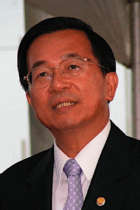 |
Chen Shui-bian 陳水扁 Chén Shuǐbiǎn (1950–) |
20 May 2000 | 20 May 2004 | 10 | 2000 4,977,737 (39.3%) | Democratic Progressive Party | Annette Lu |
| 20 May 2004 | 20 May 2008 | 11 | 2004 6,446,900 (50.11%) | |||||
| 6 |  |
Ma Ying-jeou 馬英九 Mǎ Yīngjiǔ (1950–) |
20 May 2008 | 20 May 2012 | 12 | 2008 7,658,724 (58.45%) | Kuomintang | Vincent Siew |
| 20 May 2012 | 20 May 2016 | 13 | 2012 6,891,139 (51.60%) | Wu Den-yih | ||||
| 7 | 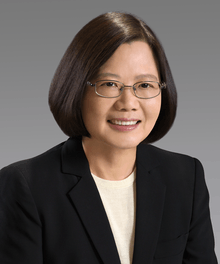 |
Tsai Ing-wen 蔡英文 Cài Yīngwén (1956–) |
20 May 2016 | Incumbent | 14 | 2016 6,894,744 (56.1%) | Democratic Progressive Party | Chen Chien-jen |
See also
- History of the Republic of China
- History of Taiwan
- Taiwan Province
- Taiwan Province, People's Republic of China
